November 2015
Fall/Winter 2015 Montgomery Botanical News is Now Online!
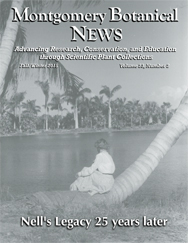 The new fall issue of the Montgomery Botanical News has articles on Nell's vision and the last 25 years at Montgomery Botanical Center. It also has articles on the future of the garden and our thoughts about what to expect by 2040.
The new fall issue of the Montgomery Botanical News has articles on Nell's vision and the last 25 years at Montgomery Botanical Center. It also has articles on the future of the garden and our thoughts about what to expect by 2040.
Please see pages 4 and 5 for graphs and a narrative showing the great increases in publications and plants in the collection over the last 25 years. On page 7, you can find information about all the great Interns and Fellows that worked at Montgomery over the summer, as well as information on a few great publications from research done on Montgomery's plant collection.
Montgomery Botanical Center publishes two newsletters a year to keep our supporters and collaborators up to date and informed. Your support is greatly appreciated and helps Montgomery meet its mission year after year. If you would like to support Montgomery online please visit our Support Us page.
To read more about how Montgomery Botanical Center meets our mission of "Advancing Research, Conservation, and Education through Scientific Plant Collections" please see our newsletters online.
October 31 - November 1, 2015
Miami-Dade Chapter 2015 FNGLA Plant Market
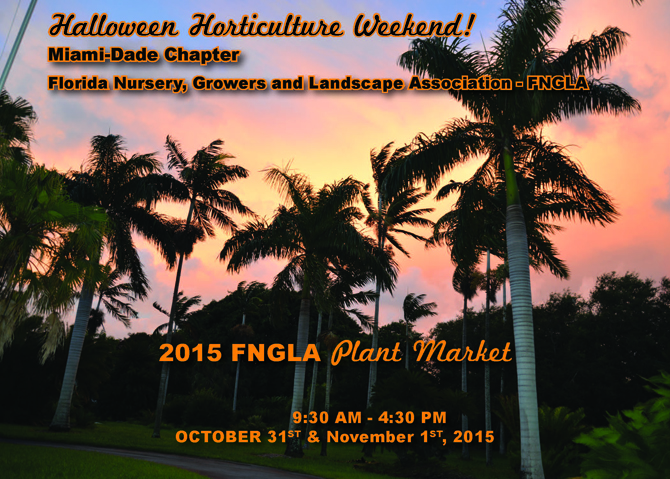
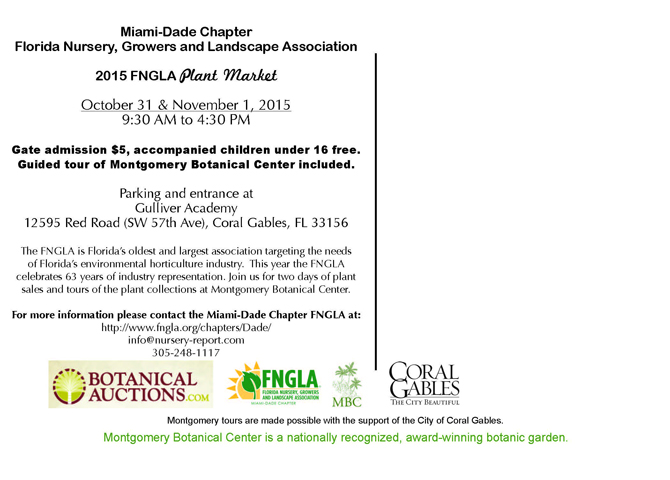
September 2015
Collecting Palms In the US Virgin Islands
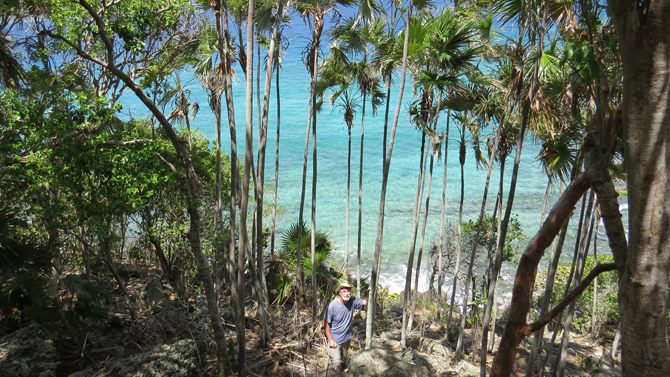
Larry Noblick recently returned from a palm collecting expedition in the US Virgin Islands. The islands are mostly composed of sedimentary and metamorphic rocks uplifted from the ocean floor due to the movement of molten magma under the sea floor. Located just east of Puerto Rico are St. Croix, St. Thomas and St. John. Larry visited St. Croix and spent a day on St. Thomas. Even though St. Croix and St. Thomas are less than 40 miles apart, the shoreline drops off rapidly into a cavernous trench over 5,000 feet deep between them; St. Thomas is riding on the North American plate, whereas St. Croix is riding on the Caribbean plate, which explains the deep trough between them.
The islands have been under a severe drought since late 2014, resulting in the death of many plants, including coconut palms. St. Croix received only two inches of rain from January to late August, when Tropical Storm Erika dropped a much needed one and a half to two inches, causing the island to recently green up. However, the drought threw off normal flowering and fruiting cycles, making palm seed hunting difficult. But diligent searching on hands and knees in some of the dry stream gullys (locally called guts) recovered seeds from the Puerto Rican Royal Palm (Roystonea borinquena). Elsewhere on the island there was no hint of fruiting, but Larry was able to take some great photos, herbarium specimens, and notes, and made friends on both islands who offered to send seed. Of particular interest is the native thatch palm, Coccothrinax alta, pictured here.
August 14-21, 2015
Cycad 2015:
Moving Cycad Science Forward!
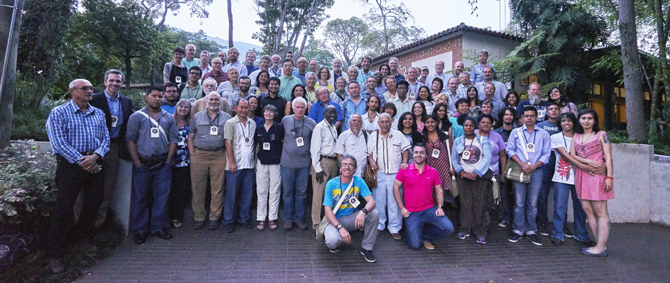
Over 100 cycad experts from 21 different countries met this past week in Medellin, Colombia, for CYCAD 2015: The 10th International Conference on Cycad Biology.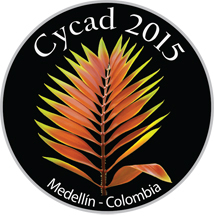
Conference Chair Dr. Cristina Lopez-Gallego, Academic Chair Michael Calonje, and Treasurer Patrick Griffith organized the activities and program, which centered on 8 plenary lectures, 55 contributed talks and 10 posters, addressing conservation, systematics, anatomy, ecology, horticulture and ethnobotany.
The weeklong gathering began and ended with exceptional food and live entertainment, featuring the wonderful cuisine and music of Colombia, and also featured a field trip to Parque Arvi, in the mountains above Medellin. Cristina also introduced a nice new feature to the group, a special “cycad forum,” with specific topics encouraging discussion and networking to address major problems in cycad work.
One very exciting development of Cycad 2015 was the official founding of the Sociedad Colombiana Cícadas (Colombian Cycad Society), launched by the “DECLARATION BY THE PARTICIPANTS OF CYCAD 2015,” which states:
Desde hace años en Colombia se vienen adelantando acciones de conservación para tratar de salvar a las Zamias de la extinción. Estas acciones incluyen investigación de sus poblaciones remanentes, esfuerzos para proteger su hábitat natural y programas para rescatar y propagar plantas para ayudar a las poblaciones empobrecidas . . . Es fundamental que más actores de la sociedad se unan y apoyen nuestros esfuerzos de conservación para salvar nuestras Zamias de la extinción.
Since years ago, conservation actions have been carried out in Colombia to try to save the Zamias from extinction. These actions include research in remnant populations, efforts to protect their natural habitat, and programs to rescue and propagate plants to help impoverished populations . . . It is imperative that more people from our society join us and support our conservation efforts to save our Zamias from extinction.
A special recognition was given to Dr. Dennis Stevenson – who participated in all 10 conferences, beginning in 1987 – for his longtime support for these gatherings, his contributions to cycad science, and his commitment to training students. The Cycad d’Or, “Golden Cycad” was presented to Dennis by Patrick, Cristina, Michael, Alan Meerow, and Angelica Cibrian Jaramillo. Dennis cited his mentors and friends from years past as sharing the honor.

The IUCN Species Survival Commission Cycad Specialist Group also met for two days prior to the main conference to complete a Red Listing project. With so much recent activity in cycad discovery and taxonomy, quite a bit of conservation assessment was needed! The CSG assessed 18 newly described Critically Endangered species, and reviewed a large number of other cycads.
The meeting, a joint effort of Universidad de Antioquia and Montgomery Botanical Center, in partnership with The New York Botanical Garden, Jardin Botanico Medellin, and the IUCN SSC Cycad Specialist Group, was supported by generous sponsorships from the Mohamed bin Zayed Species Conservation Fund, Martin-Rami Fund, and Instituto de Investigationes Alexander von Humboldt.
We are especially grateful for our educational sponsors, The Cycad Society and Cycad Society of South Africa, which funded student travel and participation in the conference – helping to develop the next generation of cycad experts!
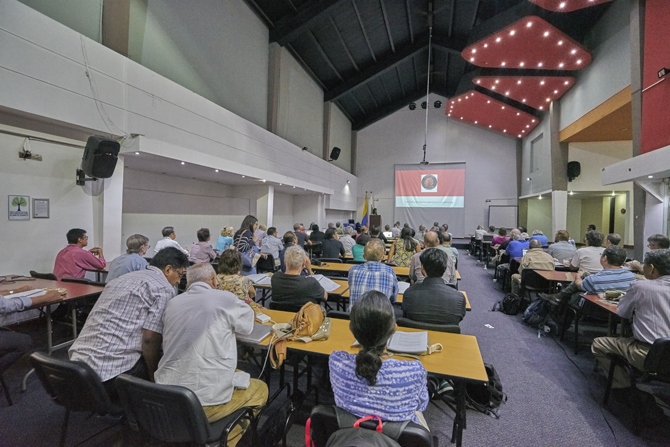
Photographs courtesy of James Clugston
August 14, 2015
Cycad Gelatinous Fibers in the American Journal of Botany
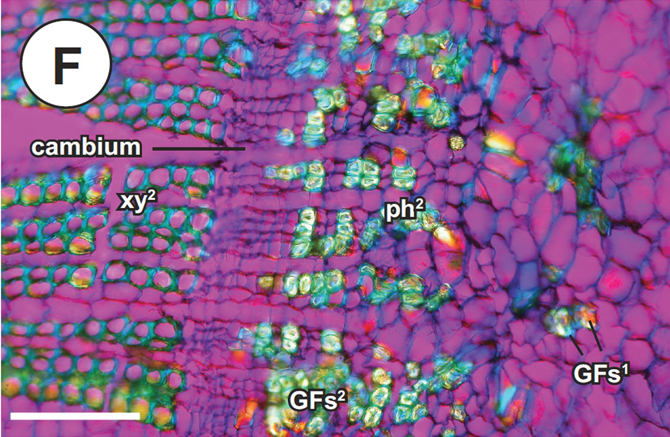
MBC’s Tracy Magellan and Patrick Griffith along with their colleague Barry Tomlinson (MBC & the Kampong) published an article in the latest issue of the American Journal of Botany on the distribution of gelatinous fibers in the radicle roots of the 10 cycad genera. The article was a follow up to the discovery of gelatinous fibers in the radicles of Cycas and Zamia, the first mention of gelatinous fibers in Cycadales.
In this paper, gelatinous fibers were found in all genera except Stangeria. Tertiary expansion was also observed within the xylem. This new anatomy discovery was rooted in traditional methods of observation. Roots were sliced with a sliding microtome, wet mounted, and observed in a compound microscope. There is still a lot of research to be done on the chemistry and the mechanism of root contraction, and we hope this paper fosters discussion and more research to be done on cycad root anatomy.
The MBC team is very grateful to the Kelly Foundation, which funded this project through the Kelly Botanical Research Fellows Program. This support brought Dr. Tomlinson from Massachusetts to work on the project at Montgomery Botanical Center.
July 2016
Montgomery Provides World Office for Cycad Conservation
Montgomery has a new role to support cycad conservation! As of this summer, MBC is now the official Programme Office for the IUCN Species Survival Commission Cycad Specialist Group.
Comprised of experts in biology, conservation, and horticulture, the Cycad Specialist Group (CSG) exists to bring together the world’s cycad conservation expertise, and to disseminate this expertise to organizations and agencies which can use this guidance.
In partnership with the IUCN Species Survival Commission, MBC will (1) Host the “Cycad Specialist Group Programme Office;” (2) Support a staff member or members as an Officer of the Cycad Specialist Group; (3) Help develop the next generation of cycad conservation expertise; (4) provide administrative and technical capacity; and (5) manage funding on behalf of Cycad Specialist Group, with no overhead fees; and (6) Collaborate with other partner organizations supporting the Cycad Specialist Group.
This official host relationship was formalized by a Memorandum of Understanding between the IUCN Species Survival Commission and Montgomery Botanical Center, on June 5, 2015. As the first official action in support of the CSG, MBC sponsored and created an updated website for up to date information about CSG activity.

June 30, 2015
New Weevil Species Honor Montgomery and its Team
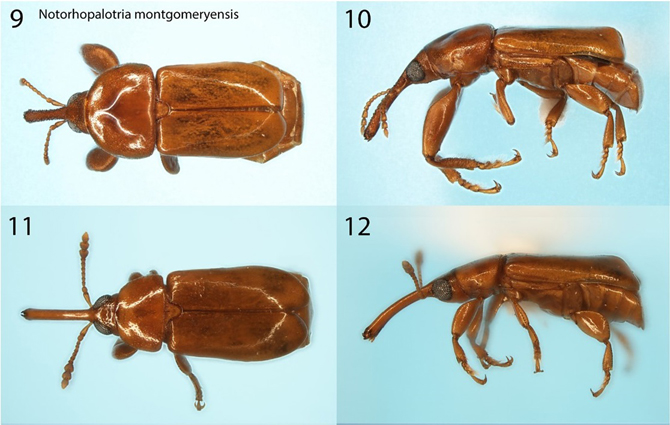
Two new species honor Montgomery! Insect experts Charles O’Brian and William Tang recently named a rare weevil after Montgomery Botanical Center and another after Cycad Biologist Michael Calonje.
Notorhopalotria montgomeryensis, known only from Costa Rica and Panama, honors MBC’s longtime work with cycads. Quoting the authors, “This species is named in honor of the Montgomery Botanical Center in Florida for its support of cycad research and conservation in the Caribbean and Central America.” The Montgomery Weevil pollinates and feeds on two cycad species, Zamia pseudomonticola and Zamia fairchildiana.
Rhopalotria calonjei is named for MBC’s longtime cycad biologist: “This species is named in honor of Michael Calonje for his work in collecting the type series of this species and many more specimens used herein, in addition to his contributions to Zamia taxonomy.” Calonje’s Weevil is only found on Zamia decumbens, the Sinkhole Cycad, in a limited area of the Maya Mountains. Michael’s work, in collaboration with experts in Belize, led to the description of that cycad in 2009.
Both species are included in a very large-scale new revision of the cycad weevils, which involved extensive field surveys, museum study, and detailed photography and microscopy. The monograph is published in Zootaxa (Volume 3970: 1-87).
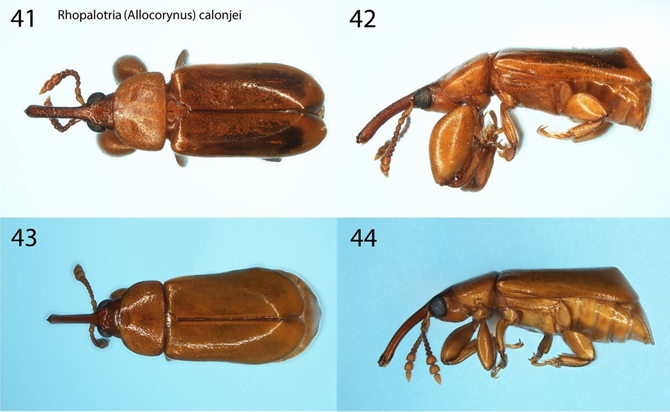
April 2, 2015
Montgomery Co-Sponsors the 27th Annual Gifford Arboretum Lecture at the University of Miami
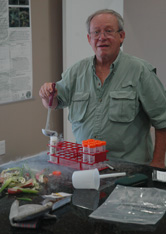 Dr. Dennis W. Stevenson, Vice President for Laboratory Research, Editor of Botanical Review, Adjunct Professor at Columbia, Cornell and Yale Universities, and Member at Montgomery Botanical Center, gave the 27th Annual Gifford Arboretum Lecture at the University of Miami titled, "Yes Bobby, Gardens and Arboreta are Relevant to the Molecular World."
Dr. Dennis W. Stevenson, Vice President for Laboratory Research, Editor of Botanical Review, Adjunct Professor at Columbia, Cornell and Yale Universities, and Member at Montgomery Botanical Center, gave the 27th Annual Gifford Arboretum Lecture at the University of Miami titled, "Yes Bobby, Gardens and Arboreta are Relevant to the Molecular World."
Dr. Stevenson discussed why living collections continue to be important to science and why their importance has never been greater.
This lecture, co-sponsored by the Gifford Arboretum at the University of Miami and Montgomery Botanical Center, was well attended. Colleagues from Florida International University, the Kampong, and other local gardens, schools, organizations, and individuals attended the informative lecture.
The Gifford Arboretum Lecture is part of the CETroB lecture series and was brought to you with the support of the City of Coral Gables and the Kelly Foundation.
April 2015
Spring/Summer 2015 Montgomery Botanical News is Now Online!
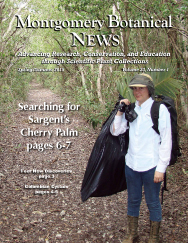 This new issue has articles on searching for Pseudophoenix on Elliott Key, collecting cycads in Colombia, more palm discoveries, and recent publications and awards received by MBC.
This new issue has articles on searching for Pseudophoenix on Elliott Key, collecting cycads in Colombia, more palm discoveries, and recent publications and awards received by MBC.
Please see pages 10 and 11 for a list of grants and support received in 2014. Your support is greatly appreciated and helps Montgomery meet its mission year after year. If you would like to support Montgomery online please visit our Support Us page.
Montgomery Botanical Center publishes two newsletters a year to keep our supporters and collaborators up to date and informed.
To read more about how Montgomery Botanical Center meets our mission of "Advancing Research, Conservation, and Education through Scientific Plant Collections" please see our newsletters online.
February 18, 2015
A Mini Dump Truck for Major Work
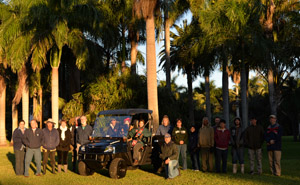 Montgomery Botanical Center is happy to announce the arrival of a new mini-dump truck. This new equipment will be used to improve landscape horticulture, plant health, and access to the plant collections.
Montgomery Botanical Center is happy to announce the arrival of a new mini-dump truck. This new equipment will be used to improve landscape horticulture, plant health, and access to the plant collections.
The vehicle will lower fuel costs throughout the year and offer better maneuverability in the landscape, allowing some tightly planted collections to be more accessible for maintenance and cleanup.
We would like to thank the Stanley Smith Horticultural Trust for their generous grant which directly benefits ornamental horticulture at Montgomery.
February 18, 2015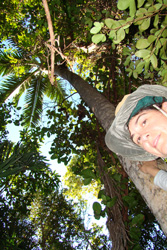
Exploring for Sargent’s Cherry Palm
Tracy Magellan, MBC Outreach Manager, recently conducted an expedition to study and collect Pseudophoenix sargentii, the Sargent’s Cherry Palm, on Elliott Key in Biscayne National Park. Elliott Key houses the only native US population of Pseudophoenix sargentii, a Florida Endangered Species.
Montgomery Botanical Center currently has five populations of Sargent’s Cherry Palm in the collection from different regions in the Caribbean. Tracy's work on Elliott Key brought back specimens and information, which highlights the need for further visits to this unique population.
MBC would like to thank the National Park Service for the scientific permit and access to Elliott Key and the International Palm Society (IPS) for generously supporting the research project.
January 22, 2015
Montgomery’s Work Featured in Leading Botany Journal
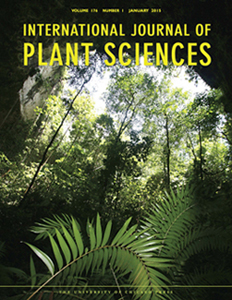 MBC fieldwork made the cover photo! The current issue of International Journal of Plant Sciences features the latest research by Montgomery and its collaborators.
MBC fieldwork made the cover photo! The current issue of International Journal of Plant Sciences features the latest research by Montgomery and its collaborators.
The paper, “Can a botanic garden cycad collection capture the genetic diversity in a wild population,” explores how well the collecting protocols at MBC preserve the native DNA in wild cycads. Using the Sinkhole Cycad, Zamia decumbens, as a model, the team compared the genes of the native cycads with those grown at Montgomery.
Michael Calonje, MBC’s Cycad Biologist, led the effort to describe this interesting species in 2009, and is coauthor on the new paper. Michael states, “Zamia decumbens is a fascinating species for this case study because it occurs in dense groups at the bottom of sinkholes and is not found in the adjacent rainforest, allowing us the unique opportunity to sample the genetic diversity of entire populations and compare it to that of seedlings derived from seeds collected in these populations.”
Patrick Griffith, MBC’s Executive Director, and lead author on the study, further adds,
This is a very fundamental question for botanic garden efforts: can we actually conserve plant species via horticulture? The answer is “yes,” if you follow careful guidelines. This is important because it provides an in-depth, scientific perspective to that basic question. Beyond that, what makes this so exciting for me is how we brought a group of experts together – a multi-institutional and international team – and worked together to produce such a useful outcome; our great colleagues made this possible.
The paper involved experts from Belize Botanic Gardens, USDA Chapman Field, and Botanic Gardens Conservation International, as well as MBC. This project was made possible in part by the Institute of Museum and Library Services (MA-05-12-0336-12), SOS – Save Our Species, and the Mohamed bin Zayed Species Conservation Fund. For more information about this conservation project, please see Montgomery’s Collections Genetics page.
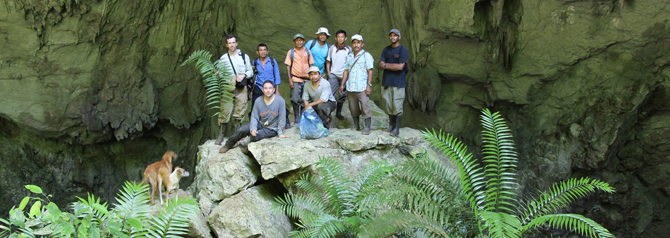
January 21, 2015
Montgomery Botanist and Colleagues Shed Light on Two Poorly Known Zamia Species from Colombia
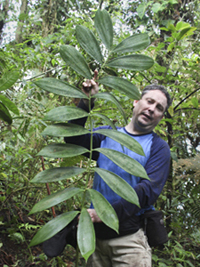 MBC’s Cycad Biologist, Michael Calonje, along with colleagues Gustavo Morales, Cristina López-Gallego, and Francisco Javier Roldán studied wild populations of Zamia in the cool cloudforests of Antioquia and Risaralda, Colombia. The populations studied represented two previously described species which were subsequently synonymized based on similarities observed in sterile herbarium specimens.
MBC’s Cycad Biologist, Michael Calonje, along with colleagues Gustavo Morales, Cristina López-Gallego, and Francisco Javier Roldán studied wild populations of Zamia in the cool cloudforests of Antioquia and Risaralda, Colombia. The populations studied represented two previously described species which were subsequently synonymized based on similarities observed in sterile herbarium specimens.
The fieldwork, supported in part by a Tinker Foundation grant in support of Michael’s Dissertation work at Florida International University, allowed the team to determine that these two species were quite distinct and deserved species recognition, to provide updated descriptions for both species, and to determine their conservation status for the IUCN’s Red List of Threatened Species.
The team’s findings were presented in a recent issue of Phytotaxa.



